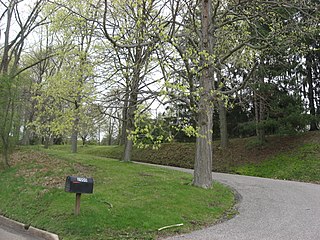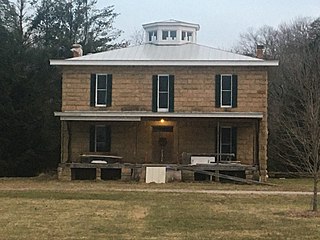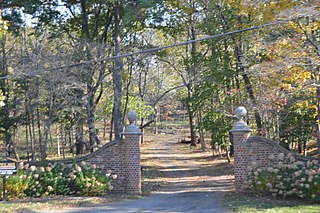
The W.H. Bickel Estate is a 2½ story stone mansion built between 1928 and 1930 on the outskirts of Parkersburg, West Virginia. The 1,800-square-foot (170 m2) building has a rectangular main section and a wing to the East. It is known for its architecture and a ghost that reportedly haunts the area. The main house is rich with woodwork, including intricately inlaid walnut and maple floors with geometric patterns, wood mantels, partial wainscoting on all three floors, 15 light French doors on the first floor, solid maple arched doors on the second floor, built-in china cabinets, crown molding in all main rooms, and original finish wood casement windows with roll down screens and brass hardware. There are five gas fireplaces with marble or stone hearths in the main house and two staircases, including a circular walnut and maple main staircase. The ceilings are coved on the second and third floors, and the third floor contains a ballroom or “dance hall” stretching twenty eight feet.

The Henry K. List House, also known as the Wheeling-Moundsville Chapter of the American Red Cross, is a historic home located at 827 Main Street in Wheeling, Ohio County, West Virginia. It was built in 1858, and consists of a two-story square main block with an offset two-story rear wing. The brick mansion features a low-pitched hipped roof with a balustraded square cupola. It has Renaissance Revival and Italianate design details. The building was once occupied by the Ohio Valley Red Cross.

Isaac Harding Duval was an adventurer and businessman prior to becoming a brigadier general in the Union Army during the American Civil War. He was a reconstruction era U.S. Representative from West Virginia in the 41st United States Congress.

Senator Stephen Benton Elkins House, also known as Halliehurst, is an historic mansion located at Elkins, Randolph County, West Virginia. It was designed by architect Charles T. Mott and built in 1890, as a summer home for U.S. Senator Stephen Benton Elkins. It consists of a three-story main block with hipped roof and service wing. The roof is punctuated by towers, turrets, dormers, and chimneys. A porch surrounds much of the first floor. It features a two-story portico with columns around a central, flat roofed tower. Located on a mountainside, it commands a view of the valley beneath and the forest and mountain peaks that surround the valley. In 1923, the house and approximately 60 acres of land were deeded to Davis & Elkins College by Sen. Elkins' widow.

Rosalie Mansion is a historic pre-Civil War mansion and historic house museum in Natchez, Mississippi. Built in 1823, it was a major influence on Antebellum architecture in the greater region, inspiring many of Natchez's grand Greek Revival mansions. During the American Civil War, it served as U.S. Army headquarters for the Natchez area from July 1863 on. It was designated a National Historic Landmark in 1989.

David and Lucy Tarr Fleming Mansion, also known as the Oxtoby Mansion, is a historic home located at Wellsburg, Brooke County, West Virginia. It was built in 1845, and is a 2+1⁄2-story, five bay, rectangular brick dwelling with a hipped roof in the Greek Revival style. It sits on a stone ashlar foundation and features a full-length portico with a hipped roof supported by six Ionic order columns. Also on the property are a contributing garage and carriage house.

Harry and Louisiana Beall Paull Mansion, also known as "Morningside" and the Charles H. and Geraldine Beall House, is a historic home located at Wellsburg, Brooke County, West Virginia. It was built in 1907–1911, and is a stuccoed dwelling in the Mediterranean Revival style with Spanish Colonial Revival style elements. It features a five bay portico with a hipped roof and eight columns. It also has wrought iron porches and pan tile roofs. It was designed by noted Wheeling architect Frederick F. Faris (1870–1927).

"Templemoor", also known as the Post-Crawford House, is a historic home located near Clarksburg approximately halfway between Romines Mills and Peeltree, in Harrison County, West Virginia. It was built in 1874 for Ira Carper Post, and is a 2+1⁄2-story brick mansion in the Italianate style. It features a combination hip and gable roof covered in polychrome slate shingles. It was the boyhood home of noted West Virginia author Melville Davisson Post (1869-1930) who was famous for mystery and fiction novels. The home includes 13 rooms, many featuring top-of-the-line woodwork.

Gen. John McCausland House, also known as "Grape Hill," is a historic home located near Pliny, Mason County, West Virginia. The main house was built in 1885, and is a two-story sandstone residence. It features a full-length, one story, five bay porch with fluted Doric order columns and metal covered hip roof. The house was built by Confederate General John McCausland (1836–1927). The boundary increase expanded the listing to include 23 additional contributing buildings and 4 contributing structures and designated it a national historic district. They include a variety of farm-related outbuildings and a log house.

Thomas R. Carskadon House also known as the Carskadon Mansion and "Radical Hill," is a historic home located on Radical Hill overlooking Mineral Street, in Keyser, Mineral County, West Virginia. It is the former residence of Thomas R. Carskadon, an influential Mineral County farmer and political leader. It was built about 1886, and has two sections: a 2+1⁄2-story rectangular, brick main block and a two-story rear ell. It features a hip-on-mansard roof and two one-story, brick polygonal bays. It combines features of the Italianate and French Second Empire styles. Also on the property are the ruins of a brick dairy, the cement foundations of a silo, and the stone foundations of another outbuilding.

Brig. Gen. John Echols House is a historic home located at Union, Monroe County, West Virginia. It was built between 1845 and 1848, and is a two-story, brick dwelling in the Greek Revival style. The house measures 44 feet, 6 inches, wide and 52 feet long. It features a hipped roof and prominent, exterior side chimneys. Also on the property is a frame, two-story house that appears to have been used for servant's quarters. The house was owned for 20 years by Brig Gen. John Echols (1823–1896), a general in the Confederate States Army during the American Civil War.

"Oakland," also known as the James M. Stephenson House, is a home located in Parkersburg, Wood County, West Virginia. Although a slaveholder and sympathizing with the Confederacy, Stephenson was also married to the sister of Unionist Arthur Boreman, and allowed then Union Army Col. James B. Steedman to use his grove nearby during the American Civil War. However, Union cavalry units occupied this his mansion for a time nonetheless, and damaged furnishings as well as the home and garden.

Blenheim is a historic home and farm complex located at Blenheim, Albemarle County, Virginia. The once very large surrounding plantation was established by John Carter. Late in the 18th century, his son Edward Carter became the county's largest landowner, and in addition to public duties including service in the Virginia General Assembly built a mansion on this plantation where he and his family resided mostly in summers, but which was destroyed by fire and sold by auction circa 1840.

Cobham Park, or Cobham Park Estate, is a historic estate located near Cobham, in Albemarle County and Louisa County, Virginia. The mansion was built in 1856, and is a rectangular 2+1⁄2-story, five bay, double pile structure covered by a hipped roof with three hipped roof dormers on each of the main slopes, and one dormer on each end. The house is an unusual example of ante-bellum period Georgian style architecture. It features front and rear, simple Doric order porches supported on square Ionic order columns. Also on the property are: two smokehouses, one brick and one frame, a frame dependency, and a simple two-story frame dwelling. It was the summer home of William Cabell Rives, Jr., (1825-1890), second son of the noted United States senator and minister to France William Cabell Rives.

Guthrie Hall is a historic mansion located near Esmont, Albemarle County, Virginia. It was built in 1901, and is a 2+1⁄2-story, seven bay, concrete structure faced in quartz in the Colonial Revival style. It is topped by a standing-seam sheet metal hipped roof with a copper wash pierced by shed-roofed dormers. The front facade features a two-story Doric order portico with three dormers that open onto the portico roof.

The Ivinson Mansion, now the Laramie Plains Museum, was built in 1892 in Laramie, Wyoming by Jane and Edward Ivinson. Designed by architect Walter E. Ware of Salt Lake City and built by local contractor Frank Cook, the house was regarded as the most significant residence in Laramie at its completion. Edward Ivinson gave the mansion to the Episcopal Church, which used it as a boarding school until 1958. After years of neglect, the house was acquired by the Laramie Plains Museum Association in 1972 and is used as a museum and events center.

Patton Mansion is a historic home located at Charlottesville, Virginia. It was built in 1907, and is a two-story, five-bay, double pile, Jeffersonian Revival Style brick dwelling. It has a hip roof and a full-height Tuscan order portico covering the center three bays of the front façade. There is a small hanging balcony with Chinese Chippendale baluster above the entrance.

Waverly Hill is a historic mansion located at Staunton, Virginia. It was designed by architect William Lawrence Bottomley (1883–1951) and built in 1929. It consists of a 2 1/2–story, five-bay, center section flanked by one-story wings connected by low, one-story hyphens in the Georgian Revival style. The house is constructed of brick, and the central section and wings are topped by slate-covered hipped roofs.

Gen. William C. Lee House is a historic home located at Dunn, Harnett County, North Carolina. It was built about 1915, and is a two-story, three-bay, double pile, Classical Revival style brick veneer mansion with a hipped roof. It has one-story rear wings and features a full facade porch with monumental Tuscan order columns. It was the home of World War II General William C. Lee, whose wife acquired it in 1935. The house contains offices for the Dunn Area Chamber of Commerce and a museum memorial to the General.

The Gen. Samuel Strong House is a historic house on West Main Street in Vergennes, Vermont. Built in 1796, it is one of Vermont's finest examples late Georgian/early Federal period architecture. It was listed on the National Register of Historic Places in 1973.























